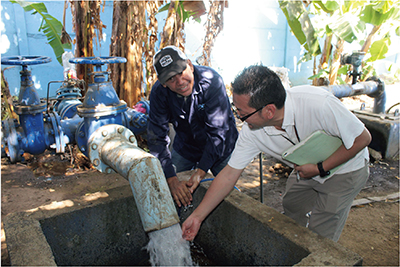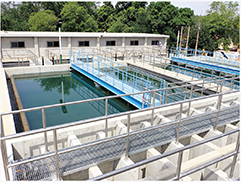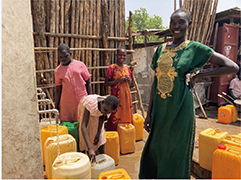(3) Water and Sanitation
Water and sanitation are vital issues linked to human life. Throughout the world, approximately 2.2 billion people do not receive a supply of safely-managed drinking water, and approximately 3.5 billion people cannot use safely-managed sanitary facilities such as toilets.Note 70 In particular, in developing countries where piped water is not widely available, women and children are often compelled to spend hours fetching water, which deprives them of opportunities for participation in society and for education. Water and sanitation issues are therefore also important for promoting gender equality and an inclusive society. Furthermore, an unstable supply of water has a negative impact on healthcare and agriculture. The development of water and sanitation infrastructure will also help create an environment that is resistant to infectious diseases, and is necessary for achieving more resilient, equitable, and sustainable universal health coverage (UHC).Note 71 SDG 6 sets forth the objective to “Ensure availability and sustainable management of water and sanitation for all.”
● Japan’s Efforts

A JICA expert confirming the demand for water transmission and distribution equipment with a counterpart from Nicaraguan Company of Aqueducts and Sanitary Sewerage (Photo: JICA)

Children at a school in the State of Koror, Palau, who are now able to wash their hands at any time at hand-washing stations newly installed with Japan’s assistance
Japan has the best track record in the world for cumulative total assistance since the 1990s in the fields of water and sanitation. In 2023, Japan provided assistance for the development and expansion of water supply and sewerage systems in countries such as Cambodia and Indonesia. In Cambodia, for instance, Japan supports Phnom Penh Capital Administration and the Ministry of Public Works and Transport in their efforts to build a sewerage management system through the development of legal and institutional systems concerning sewerage management. As for Tajikistan, Japan implemented a technical cooperation project to strengthen the water service management capacities of Pyanj and Khamadoni Vodokanals in order to improve water supply services. Currently, Japan has dispatched water service policy advisory experts to Tajikistan to follow up on the project. Furthermore, in Pakistan, Japan implements the “Project for Upgrading Sewerage and Drainage Services in Multan” and the “Project for the Improvement of Water Treatment Plant and Water Distribution System in Faisalabad,” both in Punjab province (see “Stories from the Field 4” for assistance to Cambodia, and “Featured Project” for Japan’s efforts in South Sudan).
The UN 2023 Water Conference, held in New York in May 2023, was attended by more than 6,700 people, including 20 leaders and 120 ministers from approximately 200 countries, regions, and organizations. Japan was represented by Special Envoy of the Prime Minister Kamikawa and others. Among the Conference’s five sessions, Special Envoy Kamikawa, together with Egypt, co-chaired Session 3, which mainly discussed water for climate, resilience, and the environment, and compiled key messages for strengthening the resilience of the water sector in the world, drawing on Japan’s experience in water-related disaster risk reduction. Additionally, in November, Foreign Minister Kamikawa participated through a video message in Cairo Water Week 2023, hosted by the Government of Egypt.
Japan also makes efforts to improve the water supply system in developing countries around the world in cooperation with Japanese and local private companies and organizations. For example, in Kenya, the “SDGs Verification Survey for the Measures against Non-Revenue Water of the Water Supply System by Utilizing Mechanical Joint Connections” is implemented utilizing JICA’s SDGs Business Supporting Surveys. Water leakage from water distribution pipes is a common problem in the country. As part of this survey, a pilot project was launched to utilize a Japanese company’s water pipe joint connectionsNote 72 to prevent water leakage.
In order to address the lack of local information and knowledge with regard to the problem of serious water contamination in many Asian countries, the Ministry of the Environment (MOE) of Japan implements the Water Environment Partnership in Asia (WEPA). Through cooperation among 13 participating countriesNote 73 from Asia, WEPA aims to enhance water environment governance in Asia through building human networks, gathering and sharing information, and strengthening capacity. In February 2023, the 18th WEPA Annual Meeting was held in Cambodia. It focused on the current status and challenges of industrial wastewater management. The participants shared information on progress made on water environment governance in each country and lively exchanged views. Moreover, to contribute to achieving “halving the proportion of untreated wastewater” set in Target 6.3 of the SDGs, MOE introduces Japan’s advanced decentralized wastewater treatment facility “Johkasou” technology, legislative systems, etc., mainly for Asian regions. The 11th workshop was held online in November. Presentations were made on examples of the use of treated water from “Johkasou” facilities in Japan and overseas, the Japanese legal system for maintaining good quality of treated water from these facilities, and proposed ordinances by local governments overseas regarding decentralized wastewater treatment. Active discussions were then held on these topics. This helped the participants gain a common understanding of the future direction and improvement measures to resolve the issues. Through the workshop, information on decentralized wastewater treatment systems, including the “Johkasou” facilities, was disseminated, and cooperation with people involved in decentralized wastewater treatment in each country was strengthened.
Moreover, in November, Japan jointly hosted the Seminar on Improving Water Environment in Indonesia with Indonesia’s Ministry of Environment and Forestry. At the seminar, to promote the overseas expansion of Japanese “Johkasou” facilities, Japan provided knowledge about the legal framework and maintenance of these facilities in Japan, and held discussions on future issues and initiatives regarding decentralized wastewater management in Indonesia.
Featured Project 4
South Sudan
Stable Supply of Safe and Inexpensive Water to More Residents
Project for the Improvement of Water Supply System of Juba in South Sudan
Grant Aid (June 2012 – January 2023)
South Sudan became independent in 2011, but the lives of its citizens are still under the influence of the past long-term conflicts. The basic infrastructure that supports the country’s social economy remains devastated. The water supply facilities in the capital city of Juba, built in the 1930s, were deteriorated over time due to inadequate maintenance. In addition, since the Comprehensive Peace Agreement (CPA) was concluded in 2005, the country has not been able to cope with the rapid population growth caused by the influx of internally displaced persons and others. As of 2010, only around 8% of the population had access to purified water, and many people were living on raw water from rivers or wells, making infectious diseases and the impact on economic activity an issue.
To address this challenge, Japan began supporting the expansion of water treatment facilities and the construction of new water transmission and distribution pipeline networks and water supply facilities in 2012. After some suspensions due to domestic political instability and the spread of COVID-19, the project was completed in January 2023, and began supplying water to local citizens.
With the cooperation of Japan, water supplies are now available at 8 water tanker filling stations and 120 public stands, making it possible to supply water to approximately 380,000 people a day, an increase of more than 10 times from the 34,000 people served before the facilities started operating. Water tankers and local people gather at the water supply facilities from early in the morning, and by noon all the water is distributed. Positive comments from the local people include, “It has shortened the time to get water,” and “We can now get clean water at a cheaper price than before.”
Access to safe water is a fundamental right that is essential to people’s lives. Japan will continue to protect the people’s livelihoods and support South Sudan’s state-building efforts by developing these basic socio-economic infrastructures.

Panoramic view of the completed water treatment facility (Photo: TEC International Co., Ltd.)

Women and children coming to buy water at a public stand. The demand for the water is so huge that people often line up for their turn (Photo: TEC International Co., Ltd.)
- Note 70: According to the data of UNICEF (2022). https://data.unicef.org/resources/jmp-report-2023/
- Note 71: See Note 60.
- Note 72: A part used at the joints that connect pipes together. An important component of water infrastructure to use water efficiently.
- Note 73: The 13 countries are Cambodia, China, Indonesia, Republic of Korea, Laos, Malaysia, Myanmar, Nepal, the Philippines, Sri Lanka, Thailand, Viet Nam, and Japan.
